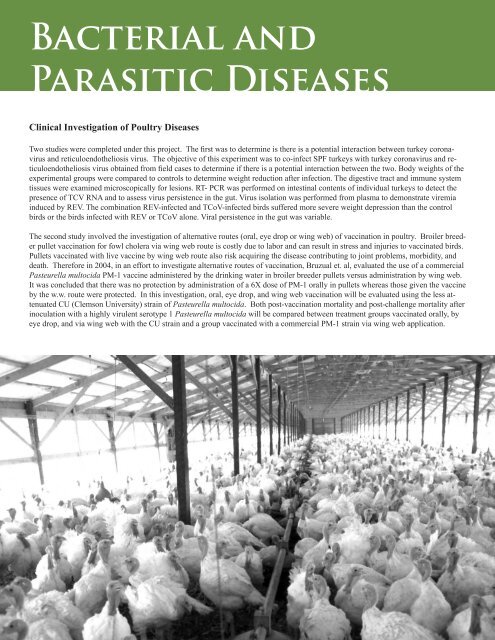The Animal Health Research Center - University of Georgia College ...
The Animal Health Research Center - University of Georgia College ...
The Animal Health Research Center - University of Georgia College ...
You also want an ePaper? Increase the reach of your titles
YUMPU automatically turns print PDFs into web optimized ePapers that Google loves.
Bacterial and<br />
Parasitic Diseases<br />
Clinical Investigation <strong>of</strong> Poultry Diseases<br />
Two studies were completed under this project. <strong>The</strong> first was to determine is there is a potential interaction between turkey coronavirus<br />
and reticuloendotheliosis virus. <strong>The</strong> objective <strong>of</strong> this experiment was to co-infect SPF turkeys with turkey coronavirus and reticuloendotheliosis<br />
virus obtained from field cases to determine if there is a potential interaction between the two. Body weights <strong>of</strong> the<br />
experimental groups were compared to controls to determine weight reduction after infection. <strong>The</strong> digestive tract and immune system<br />
tissues were examined microscopically for lesions. RT- PCR was performed on intestinal contents <strong>of</strong> individual turkeys to detect the<br />
presence <strong>of</strong> TCV RNA and to assess virus persistence in the gut. Virus isolation was performed from plasma to demonstrate viremia<br />
induced by REV. <strong>The</strong> combination REV-infected and TCoV-infected birds suffered more severe weight depression than the control<br />
birds or the birds infected with REV or TCoV alone. Viral persistence in the gut was variable.<br />
<strong>The</strong> second study involved the investigation <strong>of</strong> alternative routes (oral, eye drop or wing web) <strong>of</strong> vaccination in poultry. Broiler breeder<br />
pullet vaccination for fowl cholera via wing web route is costly due to labor and can result in stress and injuries to vaccinated birds.<br />
Pullets vaccinated with live vaccine by wing web route also risk acquiring the disease contributing to joint problems, morbidity, and<br />
death. <strong>The</strong>refore in 2004, in an effort to investigate alternative routes <strong>of</strong> vaccination, Bruzual et. al, evaluated the use <strong>of</strong> a commercial<br />
Pasteurella multocida PM-1 vaccine administered by the drinking water in broiler breeder pullets versus administration by wing web.<br />
It was concluded that there was no protection by administration <strong>of</strong> a 6X dose <strong>of</strong> PM-1 orally in pullets whereas those given the vaccine<br />
by the w.w. route were protected. In this investigation, oral, eye drop, and wing web vaccination will be evaluated using the less attenuated<br />
CU (Clemson <strong>University</strong>) strain <strong>of</strong> Pasteurella multocida. Both post-vaccination mortality and post-challenge mortality after<br />
inoculation with a highly virulent serotype 1 Pasteurella multocida will be compared between treatment groups vaccinated orally, by<br />
eye drop, and via wing web with the CU strain and a group vaccinated with a commercial PM-1 strain via wing web application.

















